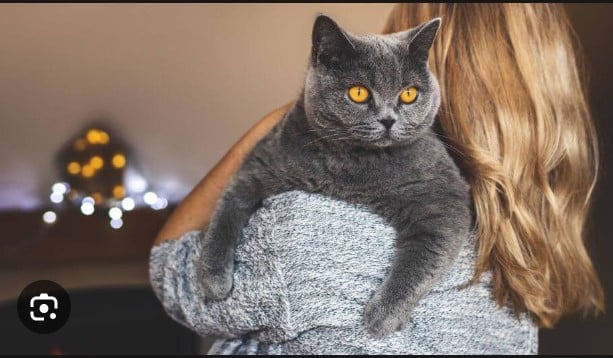For a long time, people have loved having cats as pets because of their mysterious charm and independent nature. One specific cat breed, the British Shorthair, is especially known for being elegant and friendly. In this article, we’ll take a closer look at the interesting aspects of the British Shorthair Cat Breed. We will also discuss their General Characteristics and Temperament. As well as the History of British Shorthair Cat Breed and their Care and Maintenance.
The British Shorthair is a medium-to-large-sized cat with a short, thick coat and a cute round head that gives them the appearance of a cuddly teddy bear. These cats are known for being sweet and affectionate without being overly demanding. They originated in the United Kingdom and were the original domestic shorthaired cats in the region. Initially, many of them were blue (gray), but now they come in various colors and patterns like solid, two-colored, striped, and more. Learn more about this beloved cat breed, the British Shorthair in this post.
See also: Grey and White Cat Breeds
History of British Shorthair Cat Breed
The British Shorthair’s beginnings can be traced back to the early days of cat breeding in the UK. Originally called the “British Blue,” this breed started developing in the late 1800s. Back then, cat enthusiasts aimed to preserve and improve the special traits of native British cats. They introduced crossbreeding with Persians to strengthen the bones and improve the coat’s texture.
In the early 1900s, the breed gained recognition and became well-regarded at cat shows, solidifying its status as a unique and admired breed. World War II posed challenges to the survival of the British Shorthair, disrupting breeding programs. Despite this, committed breeders worked hard to revive the breed, and by the 1960s, the British Shorthair made a strong comeback.

General Characteristics
The British Shorthair is a sizable cat, although not as huge as breeds like the Maine Coon or Siberian. Some males can weigh up to 17 pounds, while females are usually 12 pounds or less. They make great family pets because of their laid-back nature, getting along well with everyone, including kids and other animals in the home. British Shorthairs are active but not overly energetic, generally quiet, and can live happily in various-sized homes, including apartments.
See also: Brown Cat Breeds
Physical Characteristics of British Shorthair Cat Breed
Fur
The British Shorthair is known for its soft and thick fur, making it look like a teddy bear. The short coat comes in various colors like blue, black, white, cream, and tabby. The “British Blue,” a solid blue-gray color, is especially popular and shines in the light.
Body
The British Shorthair has a strong and muscular body, giving it a rounded and solid look. Its big, round head features expressive eyes in copper, gold, or blue, adding charm to the breed. The short, straight nose and small, rounded ears contribute to the cat’s balanced facial appearance.
Size
This cat is usually medium to large, with males generally bigger than females. They reach full size at around three to five years old. Adult males typically weigh between 12 to 20 pounds, while females are usually 8 to 14 pounds.
See also: What Colors Can Cats See

Temperament
Calm and Relaxed
The British Shorthair is famous for being calm and relaxed. It’s not a cat that constantly needs attention and prefers a more laid-back interaction with its human pals. This furry friend is happy to find a comfy spot, chill out, and gracefully observe its surroundings.
Loving but Self-Sufficient
While the British Shorthair enjoys love and snuggles, it also values having its own space. This breed isn’t very talkative and usually communicates through subtle actions. Unlike some more chatty cat breeds, the British Shorthair is quiet, making it a great companion for those who prefer a peaceful home.
Great with Kids and Other Pets
The British Shorthair’s friendly attitude extends to its interactions with kids and other animals. This cat is known for being patient and accepting, making it a wonderful choice for families. Its easygoing nature helps it adjust well to different surroundings, and it often forms strong connections with its human family members.
See also: Can I Gift Someone a Pet like Dog or Cat?
Fun and Smart
Despite being calm, the British Shorthair likes to play. It enjoys games and activities that challenge its mind. Puzzle toys and games that stimulate its intelligence are perfect for keeping this cat entertained. Creating a stimulating environment is essential to keep the British Shorthair both physically and mentally engaged.

Care and Maintenance of British Shorthair Cat Breed
Grooming
The British Shorthair’s short coat needs regular grooming to keep it in good shape. Brushing once or twice a week helps get rid of loose fur and avoids tangles. During shedding season, more brushing might be needed. Even though they need grooming, British Shorthairs are easier to take care of compared to cats with longer hair.
Keeping Teeth Healthy
Like many other cat breeds, British Shorthairs can have dental problems. Regular dental care is crucial to prevent tartar buildup and keep their mouths healthy. Brushing their teeth a few times a week and giving them dental treats or toys can help maintain good dental hygiene.
See also: Are Snake Plants Toxic To Cats: See How Snake Plants Can Affect Cats
Exercising
Although the British Shorthair isn’t as hyper as some cats, it still needs regular exercise and mental challenges. Toys that require interaction, structures for climbing, and puzzle feeders are good for providing both physical and mental stimulation. Playing with the cat also helps build a strong connection between the owner and the furry friend.
Diet and Nutrition
British Shorthairs are sturdy cats, but it’s important to help them stay slim and fit to avoid health problems like diabetes and heart disease, which can impact any cat but might be worse with extra weight. Give your adult British Shorthair specific amounts of food twice a day (or three times a day for young kittens), but avoid leaving food out all the time to prevent overeating and gaining too much weight. Talk to your vet for guidance on the best food for your cat.

Common Health Problems
British Shorthairs are generally very healthy and don’t often get genetic diseases. The main issue they might face is heart disease, specifically hypertrophic cardiomyopathy. However, like any cat, they can still get sick, injured, or have health problems. That’s why it’s crucial to take your cat to the vet at least once a year for a checkup. This helps make sure your cat is doing well and allows the vet to catch any potential health issues early on.
See also: What Pet to Choose between Cat and Dog: See Reasons and Comparison.
Physical Appearance
The British Shorthair is a medium-to-large-sized cat that’s sturdy and well-proportioned. Males are a bit bigger than females. A distinctive feature of this breed is its round head, with round cheeks, a strong chin, medium-sized ears, and big, round eyes. Their short coat is thick and doesn’t have an undercoat. While you often see blue British Shorthairs, they actually come in various colors and patterns.
British Shorthair Cat Breed Living Needs
British Shorthairs, like most cats, aren’t picky about their living space as long as they have caring owners who spend time with them. They strike a balance between being playful and enjoying some sunbathing. They’re up for games, like chasing mouse toys, but they’re not likely to cause trouble when you’re away, especially if you provide enough toys. Since British Shorthairs are a bigger cat breed, it’s a good idea to have at least two large litter boxes to comfortably accommodate them when they’re fully grown. A helpful guideline for choosing a litter box is that it should be as wide as your cat from his nose to the base of his tail and about half as long.
See also: Is Rosemary Safe For Cats? Find out if Rosemary is Poisonous to Cats

Prevention of Health Problems
British Shorthairs are a big and generally healthy cat breed that can live up to 20 years, but like any breed, they can face health issues.
They might be more prone to a condition called hypertrophic cardiomyopathy, where their heart muscles thicken, causing problems like difficulty breathing and loss of appetite, especially as they get older. Like other cats, they can also have urinary tract and kidney problems.
To prevent these issues, it’s a good idea to get your British Shorthair from a reputable breeder who cares for their cats’ health. Regular vet check-ups are important too, at least once a year.
Exercise is crucial for their health, as British Shorthairs have energy but aren’t super active. Without enough movement, they might gain too much weight, especially when they’re older. Use interactive toys, fishing wands, balls, lasers, and climbing structures like cat trees and shelves to keep them active and mentally stimulated from a young age.
See also: Are Poinsettias Poisonous to Cats?
Conclusion
The British Shorthair is like a symbol of charm and friendliness in the world of cat companionship. With its unique looks, gentle nature, and ability to adjust well, it’s a favored choice for cat lovers, whether you’re new to having a cat or already experienced. This royal cat becomes a beloved part of the family, bringing happiness, companionship, and a bit of British charm to any home.

